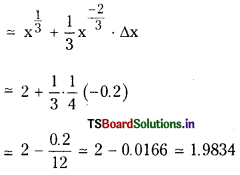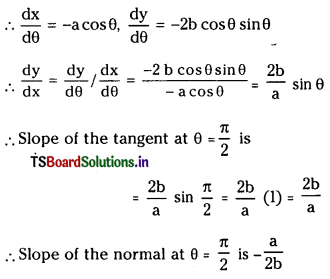Students must practice this TS Inter 1st Year Maths 1B Study Material Chapter 10 Applications of Derivatives Ex 10(a) to find a better approach to solving the problems.
TS Inter 1st Year Maths 1B Applications of Derivatives Solutions Exercise 10(a)
I.
Question 1.
Find Ay and dy for the following functions for the values of x and Ax which are shown against each of the functions. ((V.S.A.Q.)
(i) y = x2 + 3x + 6, x = 10, Δx = 0.01 (March 2014, ’11, ’05)
Answer:
f(x) = x2 + 3x + 6
Δy = f(x + Δx) – f(x)
= (x + Δx)2 + 3(x + Δx) + 6 – x2 – 3x – 6
= 2x Δx + (Δx)2 + 3
Δx = 2 (10) (0.01) + (0.01)2 + 3 (0.01)
= 0.2 + 0.0001 + 0.03 = 0.2301
dy = f’ (x) Δx = (2x + 3) Δx
= [2(10) + 3] (0.01)
= (23) × (0.01) = 0.23
(ii) y = ex + x, x = 5 and Δx = 0.02.
Answer:
Δy = f(x + Δx) – f(x)
= f (5 + 0.02) – f (5)
= f (5.02) – f(5)
= e5.02 + 5.02 – e5 – 5
= e5 e0.02 – e5 + 0.02
= e5 (e0.02 – 1) + 0.02
dy = f’ (x). Δx = (ex + 1) Δx
= (e5 + 1) (0.02)
iii) y = 5x2 + 6x + 6, x = 2 and Ax = 0.001.
Answer:
Δy = f(x + Δx) – f(x)
= f (2 + 0.001) – f(2)
= f (2.001) – f(2)
= 5 (2.001)2 + 6 (2.001) + 6 – [5(2)2 +. 6(2) + 6]
= 5 (2.001)2 + 6 (2.001) – 20 – 12
= 5 (2.001)2 + 6 (2.001) – 32
= 20.0200 + 12.0060 – 32
= 0.026005 dy = f'(x) Δx = (10x + 6) Δx = 26 (0.001) = 0.026
iv) y = \(\frac{1}{x+2}\), x = 8 and Δx = 0.02.
Answer:
Δy = f(x + Δx) – f(x)
= f (8 + 0.02) – f(8)
= f(8.02) – f (8)
= \(\frac{1}{8.02+2}-\frac{1}{8+2}\)
= \(\frac{1}{10.02}-\frac{1}{10}\)
= 0.0998003992 – 0.1000 = – 0.0001996
dy = f'(x)Δx = \(-\frac{1}{(x+2)^2}\)Δx = –\(-\frac{1}{100}\) (0.02)
= – 0.0002
v) y = cos x, x = 60° and Δx = 1°.
Answer:
Δy = f(x + Δx) – f(x)
= cos (x + Δx) – cos x
= cos (60 + 1°) – cos 60°
= 0.4848 – \(\frac{1}{2}\) = 0.4848 – 0.5 = – 0.0152
dy = f’ (x) Δx = – sin x (Δx)
= – sin60° (1°) = \(-\frac{\sqrt{3}}{2}\)(0.0174)
= -(0.8660) (0.0174) = – 0.0151
![]()
II.
Question 1.
Find the approximations of the following. ((V.S.A.Q.) (March 2013)
(i) \(\sqrt{82}\)
Answer:
82 = 81 + 1= 81 (1 + \(\frac{1}{81}\))
x = 81, Δx = 1, f(x) = √x
dy= f’ (x). Δx = \(\frac{1}{2 \sqrt{x}}\). Δx = \(\frac{1}{2 \sqrt{81}}\)(1)
= \(\frac{1}{18}\)(1) = 0.0555
f(x + Δx) – f(x) = dy
f(x + Δx) = f(x) + dy
= \(\sqrt{81}\) + 0.0555 = 9.0555 = 9.056
ii) \(\sqrt[3]{65}\) (Board Model Paper)
Answer:

iii) \(\sqrt{25.001}\)
Answer:
Let x = 25, Δx = 0.001, f(x) = √x
f(x + Δx) ≈ f(x) + f'(x)Δx
= √x + \(\frac{1}{2 \sqrt{x}}\)Δx
= 5 + \(\frac{1}{10}\) (0.001) = 5.0001
(iv) \(\sqrt[3]{7.8}\)
Answer:
x = 8, Δx = -0.2, f(x) = \(\sqrt[3]{x}\)
f(x + Δx) ≈ f(x) + f'(x) Δx

(v) sin 62°
Answer:
Let x = 60°, Δx = 2°, f(x) = sin x
∴ f(x + Δx) = f(x) + f'(x) Δx
= sin x + cos x Δx
= sin 60° + cos 60°. (2°)
= \(\frac{\sqrt{3}}{2}+\frac{1}{2}\)(2°)
= 0.8660 + 0.0174 = 0.8834
(vi) cos (60° 5′)
Answer:
x = 60°, Δx = 5′ = \(\frac{5}{60} \times \frac{\pi}{180}=\frac{\pi}{2160}\) = 0.001453
f(x) = cos x
∴ f(x + Δx) – f(x) + f'(x) Δx
= cos x – sin x Δx
= cos60° – sin60° (0.001453)
= 0.5 – 0.8660 (0.001453)
= 0.5 – 0.001258 = 0.4987
vii) \(\sqrt[4]{17}\)
Answer:
Let x =16, Δx = 1, f(x) = \(\frac{1}{4}\) = x1/4
.-. f(x + Δx) = f (x) + f’(x) Δx
= x\(\frac{1}{4}\) + \(\frac{1}{4}\)x\(\frac{-3}{4}\)
= 16\(\frac{1}{4}\) + \(\frac{1}{4}\)16\(\frac{-3}{4}\) Δx
= 2 + \(\frac{1}{32}\)(1)
= 2 + 0.0312 ≈ 2.0312
![]()
Question 2.
If the increase in the side of a square is 4% then find the approximate percentage of increase in the area of the square. (S.A.Q.) (May 2014)
Answer:
Let x be the side of the square and given
= \(\frac{\Delta \mathrm{x}}{\mathrm{x}}\) × 100
Area of square A = x2
Error ΔA = 2x Δx
Relative error = \(\frac{\Delta \mathrm{A}}{\mathrm{A}}=\frac{2 \mathrm{x} \Delta \mathrm{x}}{\mathrm{x}^2}=2 \cdot \frac{\Delta \mathrm{x}}{\mathrm{x}}\)
% error in area of the square
= 2. \(\frac{\Delta x}{x}\) × 100 = 2 × 4 = 8
Question 3.
The radius of a sphere is measured as 14 cm. Later it was found that there is an error of 0.02 cm in measuring the radius. Find the approximate error in surface area of the sphere. (S.A.Q.)
Answer:
Let r be the radius of sphere = 14
Also given Δr = 0.02
We have surface area of the sphere A = 4πr2
Approximate error in surface area of sphere
∴ ΔA = 8πr Δr = 8π × 14 × 0.02 = 2.24 π
= (2.24) (3.14) = 7.0336
Question 4.
The diameter of a sphere is measured to be 40 cm. If an error of 0.02 cm is made in it then find approximate errors in volume and surface area of the sphere. (SA.Q.)
Answer:
Let V be the volume of sphere
Then V = \(\frac{4}{3}\)πr3 = \(\frac{4}{3} \pi\left(\frac{\mathrm{d}}{2}\right)^3=\frac{\pi \mathrm{d}^3}{6}\)
Approximate error in volume ΔV = \(\frac{\pi}{6}\)3d2 Δd
= \(\frac{\pi}{2}\)d2 Δd
Given Δd = 0.02, d = 40
∴ ΔV= \(\frac{\pi}{2}\)(40)2 (0.02)
= π (1600) (0.01) = 16π
Surface Area S = 4πr2
= 4π \(\left(\frac{\mathrm{d}}{2}\right)^2\) = πd2
Approximate error in surface area
ΔS = π 2d . Δd = 2π (40) (0.02) = 1.6 π
![]()
Question 5.
The time’t’ of a complete oscillation of a simple pendulum of length l is given by t = 271 y g , where g is gravitational constant. Find the approximate percentage in error of t when the percentage error in l is 1 %. (S.A.Q.)
Answer:
Given t = 2π\(\sqrt{\frac{l}{g}}\)
log t = log 2π + \(\frac{1}{2}\) [log l – log g]
\(\frac{\Delta \mathrm{t}}{\mathrm{t}}=\frac{1}{2} \frac{\Delta l}{l}\) (∵ 2π; g are constants)
Given \(\frac{\Delta l}{l}\) × 100 = 1
∴ Approximate percentage error of t is
\(\frac{\Delta t}{t}\) × 100 = \(\frac{1}{2} \frac{\Delta l}{l}\) × 100
= \(\frac{1}{2}\)(1) = \(\frac{1}{2}\)